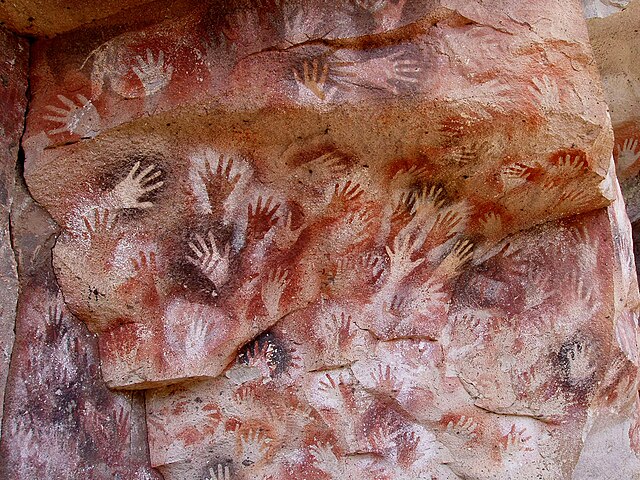Prehistory
span of time before recorded history From Wikipedia, the free encyclopedia
Remove ads
Prehistory (or better known as Pre-history) is the time before people began to write. It lasted from around 4.5 billion BC – 3000 BC, during the Stone Age.

Name
The word comes from the Ancient Greek words προ (pre = "before") and ιστορία (historia = "history").
Paul Tournal first used the French word Préhistorique. He found things made by humans more than ten thousand years ago in some caves in France. The word was first used in France around 1830 to talk about the time before writing. Daniel Wilson used it in English in 1851.
Meaning
The term "pre-history" is mostly used for the period from 4.5 billion BC – 3000 BC, roughly speaking, the Neolithic. Sometimes the term "prehistoric" is used for much older periods, but scientists have more accurate terms for those more ancient times.
Pre-history ends when people began to write. This happened at different times in different places, depending on when people began to write and whether their records were kept safe so they could be found later on. In places like Mesopotamia, China, and Ancient Egypt, people recorded things from very early times (around 3200 BC in Ancient Egypt), and these records can be looked at and studied. In New Guinea, the end of prehistory came much later, around 1900 BC.
Remove ads
Studying pre-history
Less is known about prehistoric people because there are no written records for us to study. Archaeologists study things like tools, bones, buildings and cave drawings to learn about pre-history. Palaeontology, astronomy, biology, geology, anthropology, and archaeology also provide information about pre-history. For example, anthropologists study the traces of human behavior to learn what people were doing and why.

After people started to record events, first by drawing symbols (called pictographs) and then by writing, it became much easier to tell what happened, and history started. These records can tell us the names of leaders (such as Kings and Queens), important events like floods and wars, and the things people did in their daily lives.
Life
In the more ancient Stone Age pre-history, people gathered in tribes and lived in caves or tents made from animal skin. They had simple tools made from wood and bones, and cutting tools from stone such as flint, which they used to hunt and to make simple things. They made fire and used it for cooking and to stay warm. They made clothing out of animal skins, and later by weaving.
Society started when people began doing specialized jobs. This is called the division of labour. The division of labor made people depend on one another and led to more complex civilizations.
Remove ads
Timeline of Earth
- 4.5 billion years ago – Earth forms out of smaller rocks flying around the Sun
- 3,500 million years ago – The first very simple and tiny forms of life appear in the seas
- 600 million years ago – The first animals (also in the seas)
- 500 million years ago – The first plants and animals on land
- 230 million years ago – The first dinosaurs
- 65 million years ago – Dinosaurs disappear; mammals take their place as the dominant animals
- 30 million years ago – The first apes
- 2.5 million years ago – The first humans


Remove ads
Timeline of people
- 2.5 million years ago – Start of Lower Palaeolithic age, during which a type of early pre-human called Australopithecus lived. These people made tools out of bones and stones and made shelters out of branches.
- 1 million years ago – A type of early human called Homo erectus lived. People made hand axes and wooden spears.
- 250,000 years ago – First Homo sapiens (modern people). People make fire, use bolas, and hunt elephants.
- 100,000 years ago – Middle Palaeolithic age. Neanderthal people live during this period. People live in caves and make cave drawings. People begin to bury the dead.
- 40,000 years ago – Upper Palaeolithic age. Cro-Magnon people exist. People make spears from antlers and houses from hides (animal skins). People paint cave drawings and make things out of clay. People make needles out of antlers and make jewelry.
- 10,000 years ago – The last Ice age ends.
- 10,000 BC – 4000 BC – Mesolithic age. In North-west Europe people make bows and arrows. People use dogs to hunt and to carry things.
- 9,000 BC – Neolithic age. People in the Near East start to change from hunting and gathering food to growing crops and using farm animals.
- 7,000 BC – People in South-west Europe begin using copper to make tools.
- 6,000 BC – British Isles move away from Europe.
- 2,580 BC – The Egyptians build the Great Pyramids in Giza. People in the Middle East use iron and make plows.
- 2,400 BC – People make Stonehenge in England.
- 3,300 BC – 1,200 BC – Bronze Age (in Britain). People make tools out of bronze.
- 1,200 BC – 400 AD – Iron Age (in Britain). People make tools out of iron. Roman Empire rises and falls.
Remove ads
Related pages
Wikiwand - on
Seamless Wikipedia browsing. On steroids.
Remove ads
